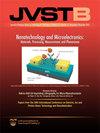用SF6和O2等离子体刻蚀Cr和CrOx
IF 1.4
4区 工程技术
引用次数: 4
摘要
铬是现代纳米制造中经常遇到的材料,直接作为功能材料(例如,光掩膜的生成)或间接作为硬掩膜(例如,蚀刻石英)。随着器件尺寸的不断缩小,图案化Cr和CrOx的特征尺寸控制变得越来越重要。Cr和CrOx蚀刻通常使用氯氧基等离子体化学方法进行,但纳米尺度施加了限制。在这项工作中,首次使用氟氧基等离子体证明了定向蚀刻。研究了两种情况来证明Cr蚀刻性能:(i) SF6 + O2的等离子体混合物和(ii) SF6/O2切换过程,其中等离子体依次使用。所提出的混合物在300 W压板功率下具有高达400 nm/min的Cr蚀刻速率(ERs),当SF6/O2气体比为~ 0.75%时,即几乎纯O2等离子体时,Cr蚀刻速率(ERs)最高。由于420v的高自偏置,腐蚀选择性较低,对Si的选择性小于5。等离子体混合物的选择性可以在较低的等离子体功率下得到改善,但这伴随着相当大的削弱。CrOx的蚀刻无需在进料中添加O2,因此,ER可以达到更高的值(在300 W时超过2000 nm/min)。由于等离子体混合物似乎不足,在保持方向性的同时,提高了选择性,研究了顺序过程。高选择性是通过使用相对较低的等离子体功率(以确保低自偏置)实现的,方向性是由于SF6和O2等离子体的时间分离以及对CrFx蚀刻抑制物质的可控定向去除。在30 W等离子体功率下使用这样的开关过程,可以实现超过20的选择性,具有良好的轮廓方向性,并且每个周期的蚀刻速率为1 nm(或7 nm/min)。本文章由计算机程序翻译,如有差异,请以英文原文为准。
Cr and CrOx etching using SF6 and O2 plasma
Chromium is a frequently encountered material in modern nanofabrication, directly as a functional material (e.g., photomask generation) or indirectly as a hard mask (e.g., to etch quartz). With the continuous downscaling of devices, the control of the feature size of patterned Cr and CrOx becomes increasingly important. Cr and CrOx etching is typically performed using chlorine–oxygen-based plasma chemistries, but the nanoscale imposes limitations. In this work, directional etching is demonstrated for the first time using fluorine–oxygen-based plasma. Two cases are studied to demonstrate the Cr etch performance: (i) a plasma mixture of SF6 + O2 and (ii) a switching SF6/O2 procedure in which the plasmas are used sequentially. The proposed mixture performs with Cr etch rates (ERs) up to 400 nm/min at 300 W platen power and is highest when the SF6/O2 gas ratio is ∼0.75%, i.e., almost pure O2 plasma. The profile shows reasonable directionality but the etch selectivity is low, less than 5 toward Si, due to the high generated self-bias of 420 V. The selectivity of the plasma mixture can be improved at a lower plasma power, but this is accompanied with considerable undercut. The etching of CrOx proceeds without the need for O2 in the feed, and, therefore, the ER can reach much higher values (beyond 2000 nm/min at 300 W). As the plasma mixture seems to be inadequate, a sequential process is studied with improved selectivity while preserving directionality. The high selectivity is achieved by using relatively low plasma power (to ensure a low self-bias) and the directionality is due to the time separation of the SF6 and O2 plasmas and a controlled directional removal of CrFx etch inhibiting species. Using such a switched procedure at 30 W plasma power, a selectivity beyond 20 with good profile directionality is achieved and having an etch rate of ∼1 nm per cycle (or 7 nm/min).
求助全文
通过发布文献求助,成功后即可免费获取论文全文。
去求助
来源期刊

Journal of Vacuum Science & Technology B
工程技术-工程:电子与电气
自引率
14.30%
发文量
0
审稿时长
2.5 months
期刊介绍:
Journal of Vacuum Science & Technology B emphasizes processing, measurement and phenomena associated with micrometer and nanometer structures and devices. Processing may include vacuum processing, plasma processing and microlithography among others, while measurement refers to a wide range of materials and device characterization methods for understanding the physics and chemistry of submicron and nanometer structures and devices.
 求助内容:
求助内容: 应助结果提醒方式:
应助结果提醒方式:


